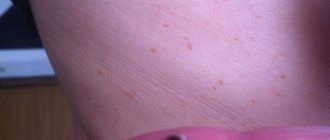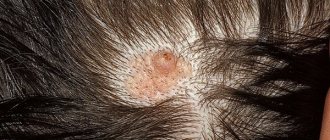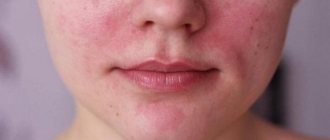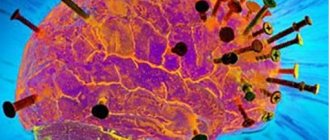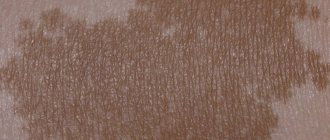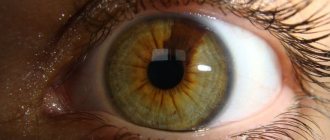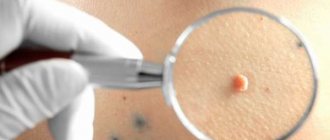Moles are initially benign formations.
How and why moles appear in people is a long-established and safe circumstance for health. But under the influence of certain factors they can degenerate. So, if a mole becomes inflamed, it can cause cancer. For the malignant process to start, the element must degenerate into melanoma.
If inflammation appears on a mole, this may be the first stage of cancer.
You can understand that degeneration is taking place by the following signs:
- You can see a red area around the mole
- The color of the nevus begins to change. It can be either light or dark
- Moles on the body enlarge or change color and shape, their edges become uneven and indistinct
- The nevus suddenly began to change its size. The faster the mole grows, the more serious the consequences will be.
But why does it do this? Many factors can cause the degeneration of a nevus, but in general they are divided into two categories: household trauma, exposure to the sun.
If a person has pale skin and has freckles on it, then in this case the person should avoid excessive exposure to the sun. Long-term exposure to ultraviolet radiation is not good for anyone, but especially for these people.
A person can be injured in everyday life due to various circumstances. Even a small abrasion can cause infection. This, in turn, can affect moles.
If you notice that some element on the body has begun to behave differently than it did before, then you urgently need to contact an oncologist and dermatologist.
Moles can settle anywhere on the human body, even on the eyeball, nose and mucous membranes. Such cases have been recorded in medicine. And depending on the type, some moles can be removed, while others cannot.
Causes
- Mechanical damage. If a mole is injured as a result of friction against clothing, involuntary tearing, or scratching, then its integrity is compromised and thus an entry point for infection is formed. When there are a lot of microbes, the skin structures become inflamed and can fester.
- Prolonged sunbathing is dangerous not only due to increased production of melanin on the skin (and there is already an excess of it in nevi), but also due to increased sweating and overheating of the dermis. Excessive sweating creates favorable conditions on the skin for the growth of pathogenic microflora.
- Skin pathologies. With them, inflammatory processes can develop in the epidermis, often leading to suppuration in acne, eczema, dermatitis, scabies, and furunculosis.
- Immunodeficiencies. With them, the skin partially loses its protective functions and becomes easily infected.
- Exchange disorders. Diseases such as hyperthyroidism, diabetes mellitus and obesity are accompanied by the development of skin pathologies and the appearance of various rashes on the human body; such a rash can also form under moles.
- Degeneration of nevi. It is manifested by the formation of ulcers, elevations, tubercles on it, a change in its previous color, regular bleeding, and hair loss.
- Dysfunctions in the sebaceous glands. In such cases, as a result of the accumulation of excess fat, the skin pores and omentums are poorly cleaned and become inflamed when bacteria or fungi enter.
- Folliculitis. A disease in which hair follicles are affected and suppurated.
Thus, the mechanism of formation of pus inside a mole is due to the penetration of microbes into its superficial or deep layers, as well as into the areas of the hair follicle and sebaceous glands, which cause their inflammation.
Can a nevus change due to friction?
Due to constant friction, any formation on the body changes its original appearance. In some cases, damaged, chafed moles may turn black or red. Sometimes they begin to inflate and increase in size.
Red nevi, which are located on the scalp, swell after mechanical action, their color acquires a rich shade. Brown and other dark raised pigment spots are characterized by the appearance of redness, the acquisition of a glossy sheen, and an increase in size. Hanging papillomas, found on the neck and armpits, increase in size and rarely change color. If such a growth darkens, this indicates its damage and imminent death.
When it gets dark, it begins to peel, itch, and hurt due to repeated damage - raising suspicions about the onset of a malignant process. Any modifications of pigment formations should be alarming and become a reason for a visit to the doctor.
Chafing is unpleasant, but not dangerous. If this happened once and did not cause damage, you can get by with auxiliary therapy. If injuries occur regularly, clothing often rubs the mole, you need to think about removal. Otherwise, a person will face a number of serious complications, one of which may be a cancer process.
Signs and diagnosis
The discharge of pus from a mole is accompanied by a number of characteristic symptoms:
- the appearance of redness and pronounced swelling around the nevus;
- swelling or protrusion in the area of the mole;
- painful to touch and at rest.
Sometimes the following may be observed: a rise in body temperature to moderate levels (up to 37-37.7), the appearance of lethargy and weakness, skin itching and burning, blood from a mole.
When a mole has festered, it is not recommended to use a biopsy (taking a piece of it for histological examination), since this manipulation can contribute to the spread of infection to neighboring areas.
Usually, in such cases, a dermoscope is used and the festering tumors are examined in detail.
To determine the type of pathogenic microorganisms, scrapings are taken from the areas of the skin closest to inflammation.
Melanoma
This is a type of cancer that occurs due to direct exposure to ultraviolet rays on the pigment cells of the skin. Melanoma is a dangerous disease. This is due to two reasons:
- the ability of a nevus to become an atypical neoplasm in a short time,
- the appearance of such a neoplasm leads to the appearance of a disease such as cancer.
If a mole becomes inflamed (red and hurts) or there is redness around the mole, this is a direct reason to seek help from a specialist.
The general clinical picture can be supplemented by:
- uneven edges,
- one half of the nevus is different from the other,
- heterogeneous coloring of the nevus,
- redness around the mole,
- nevus compaction.
In case of untimely diagnosis or unwillingness to consult a doctor in a timely manner, symptoms appear that indicate the active activity of the malignant process:
- the formation of numerous cracks on the surface of the nevus,
- blood comes from the nevus,
- significant weight loss.
There are also multiple enlargements of the lymph nodes and the appearance of corresponding pain upon palpation.
Dangerous moles that degenerate into melanoma
Treatment
First of all, the root cause of nevus suppuration, that is, the causative agent of the disease, is identified. In case of bacterial infection, the mole is treated with various ointments based on antibiotics and strong aseptic agents.
Since there is a risk of nevi degenerating into malignant formations and any inflammatory processes in them can provoke this, it is necessary to show the suppuration to a dermatologist or oncologist, undergo a full examination and follow all the instructions of specialists in the treatment of inflammation. Self-medication in such cases can only cause harm and cause serious complications.
Surgical removal of moles may be recommended in cases where they are constantly injured and have become inflamed more than once. Modern methods of eliminating them are laser exposure or cryofreezing.
With laser destruction, moles are destroyed with a directed beam, which heats their cells and they evaporate. After such an operation, a small scar remains, which resolves in less than a week.
Nevi are also removed by exposing them to low frequency currents - by electrocoagulation.
You can get rid of moles located in the upper layers of the epidermis using a radio wave knife (irradiation with high frequency waves). And during cryofreezing, they are exposed to a special applicator with liquid nitrogen, and the neoplasm cells instantly die.
How to deal with the pathological process?
If the spring not only begins to change, but also begins to fester, then you urgently need to go to the hospital without delay.
The doctor will examine the element and prescribe treatment to help resolve the problem.
How to identify a malignant mole? - A biopsy may be needed. This procedure involves the removal of a small element of tissue for subsequent examination to determine whether there are prerequisites for oncology.
But many people believe that a biopsy is impossible and even harmful. Doctors explain their position by saying that the mole is already inflamed and unnecessary injury will further aggravate the situation. Moreover, there is an alternative - computer diagnostics and dermatoscopy .
If the doctor’s fears are confirmed, and the spring actually begins to degenerate, then the patient will be offered to remove it.
But what to do if you notice that your nevus is inflamed, but you won’t be able to get to the hospital in the near future? Is it possible to help yourself in this situation at home? What happens if a mole is also accidentally torn off?
To provide first aid for an inflamed mole, you will need alcohol, calendula tincture, and an ointment that contains an antibiotic.
You can treat yourself at home using the following recipes:
- An inflamed mole should be disinfected with alcohol . So, you need to do it until you recover. Alcohol can be changed alternately with calendula tincture
- Antibiotic ointment may also help . It is especially good if the composition contains zinc and salicylic acid
- You can sprinkle Streptocide on the surface of the mole . It is first ground into powder. The sore spot is also lubricated with flax oil.
- The cotton wool needs to be moistened in the infusion of celandine . Then use this product as a lotion for 10 minutes. So, you need to do it three times a day
To protect yourself from cancer due to injury to a mole, you need to wear good and comfortable clothes, and also take care of your manicure. Nails can seriously injure the mole, as can tight clothing that will rub against the nevus, inflaming it.
Causes of complications after the procedure
The speed of skin recovery after the procedure and the likelihood of negative consequences are influenced by the method of destruction of the birthmark and the thoroughness of care during the rehabilitation period.
- Layer-by-layer removal of moles with a laser is considered effective and low-traumatic. The risks of complications are minimal. A small scar and pigmentation of skin cells may be observed at the site of the removed formation.
- Freezing with liquid nitrogen does not guarantee complete destruction of the seal. It is impossible to regulate the depth of nitrogen penetration under the skin. The effect may be temporary. There is a threat of relapse.
- The knot of pigmented cells is removed using an electrocoagulator. The surgitron coagulator is widely used in gynecology to remove moles on the cervix.
- Excision with a radio knife is a safe, effective method.
- A scalpel is used to remove malignant tumors that can develop into cancer.
Prevention
Despite all its apparent danger, melanoma belongs to the category of diseases that, with the right approach and following the appropriate recommendations, are easier to prevent than to subsequently treat. To do this you need:
- Avoid exposure to sunlight on exposed skin, especially from 12 to 15 hours, when sun activity reaches its maximum.
- In cases where the nevus is accidentally damaged, the resulting wound must be treated with an antiseptic. If the mole turns red or a red spot has formed around the mole, you should see a doctor immediately.
- If hair has grown on the nevus, it should not be pulled out, but should be carefully trimmed with nail scissors.
- It is necessary to constantly examine your skin for the presence of even the most minor microtraumas. Any deformation of the nevus, and especially if the mole becomes inflamed and red, is a reason to consult a doctor.
The damaged growth should be treated with an antiseptic
Risk factors
According to recent, numerous scientific experiments, it was found that women, unlike men, have a greater tendency to develop melanoma. It is important to highlight that a malignant tumor can be localized separately on an area of the skin or on the nevus itself. Most often, the legs are affected by the pathological process, and a little less often the upper limbs and abdomen. A mole on the face and neck can also become inflamed, swollen, fester and cause many other problems.
People who are characterized by fair skin covered with freckles, as well as patients with a hereditary predisposition, constitute the main risk group. It is in these people that inflammation of the nevus or redness of the mole can result in malignant degeneration.
The above category of people should undergo regular examination by an oncologist and pay maximum attention to any change in the birthmark.
Pale skin and freckles are one of the risk factors for melanoma
Associated symptoms and mechanism of action
Contact your doctor if you have the following symptoms:
- a swollen mole with a change in color (blackened, reddened), shape (ball), size;
- the surface of the neoplasm has become denser, lumpy, and uneven;
- itching, burning;
- formation of small bubbles;
- asymmetrical arrangement;
- discharge of blood, other fluid (pus), inflammation;
- a crust has formed;
- a blister appears next to the nevus;
- hanging birthmark;
- change in skin color around the nevus.
Doctors recommend removing a birthmark if it is in an awkward location or if it rubs against clothing (back, armpits, groin area).
Proper care is required after removal:
- 1-7 days after removal, a dark crust forms, which cannot be removed so as not to introduce infection into the wound. After a week, the dark crust will come off and a pink crust will form. It is not recommended to lubricate damaged skin with decorative cosmetics or drink alcohol (vasodilatation can cause bleeding). It is necessary to treat the skin with antiseptic solutions (carbon peroxide, potassium permanganate).
- Avoid staying in water for a long time - the nevus becomes wet and swells. Getting wet provokes rejection of the mole tissue.
- Avoid sudden hypothermia or overheating.
- After removing the crusts, no special care is required.
- During healing, prolonged exposure to the sun, visiting solariums, baths, steam rooms, saunas, and public places are not recommended.
- Avoid mechanical damage (injury, burns).
- As prescribed by the doctor, apply creams and anesthetics to the damaged area.
If, after removal, redness, swelling appears and does not go away, the damaged area itches, or pain occurs when pressed, you should contact your doctor again.
What to do if a boil has formed under a mole
If there is strong pigmentation on the face, a red halo, swelling, abscesses around the mole, you cannot try to release the abscess on your own. Additionally, it will damage the skin and cause inflammation.
Allowed to do it yourself:
- free the skin from stale and chafing clothing. If it is a head, discard the headdress;
- isolate the site of inflammation from external contact, even covering it with a band-aid during a shower;
- hide the boil from sunlight;
- avoid stuffy rooms and any skin irritants (if you have allergies, get rid of the allergen);
- Check the mole periodically for increased pus, discoloration, or redness.
In order not to provoke the appearance of a malignant tumor, you should avoid cosmetics during your illness. It clogs pores and prevents skin cells from breathing normally and exchanging substances.
Do the same with creams, ointments and poultices. Independent use of traditional medicine will aggravate the course of the disease with new problems.
Self-medication is the path to surgery, a scar, and long rehabilitation.
Which doctor should you go to if a mole becomes inflamed?
At the first suspicion, you should contact doctors with specialization in dermatology and oncology. The doctor must examine not only the problem area, but also all other birthmarks, to find out the cause of damage or changes in the nevus.
At the slightest suspicion of cancer, it is recommended to perform a biopsy procedure to exclude the malignant nature of the changes.
If the presence of melanoma is not confirmed, the doctor will perform a siascopic test to determine the complexity of the inflammation. After this, the mole can simply be cauterized or removed surgically, for example, with a laser.
The healing process is quick and painless. If a biopsy was not performed before the removal procedure, then it must be performed on the removed mole.
Why can a mole swell?
Traumatic factors that cause a swollen mole:
- Mechanical damage. Nevi do not affect a person’s life rhythm, but if they are poorly placed, there is a risk of injury. Such places include the neck, head, armpits, groin, legs and face. Items of clothing, shoes, and hair removal cause rubbing or tearing off of the mole. Children are more often exposed to mechanical damage.
- Chemical exposure. Products that consist of chemical components have a negative effect. Cosmetics containing excessive amounts of synthetics, hygiene products or household chemicals that contain abrasive substances.
In the absence of injury to the nevus, redness or swelling occurs due to the following factors:
- The beginning of the process of degeneration of a mole into a malignant tumor poses a danger to life. At the initial stage, melanoma can be treated without the risk of death. The condition is a timely visit to a doctor who will conduct an examination and identify the nature of the mole.
- Prolonged exposure to open sunlight provokes the appearance of new nevi or the transformation of old spots. It is not recommended to be in the sun in the summer from 10 am to 4 pm, when ultraviolet radiation is most aggressive.
- Hormonal imbalances appear in adolescence, during pregnancy, menopause, and lactation. Hormonal imbalance also occurs during treatment with hormonal drugs, abortion, and thyroid diseases.
- When you try to remove the formation yourself. There are means and methods of traditional medicine that promise to rid a person of the stain. Doctors say that resorting to self-removal is prohibited. With the help of such means, you can get rid of the upper layer of the nevus, while the base of the spot remains deep in the dermis.
- A hair was removed from the formation. Removing hair from the surface of the formation causes skin damage and increases the risk of infection. The onset of the inflammatory process is characterized by itching and swelling.
In addition to the fact that the mole is swollen, the clear boundary of the spot disappears, the shape changes, and symmetry disappears. The nevus becomes dark or red, its size increases, and a blister appears around it. When in contact with clothing or another object, pain and burning are felt. An inflamed nevus causes the following diseases: oncology, hormonal imbalance, malfunction of the cardiovascular system. In addition, gastrointestinal disease, vitamin K deficiency, and liver failure may occur.
Pus from a mole
There are often cases in which the nevus can become inflamed and fester. With light palpation of the nevus, a significant compaction is identified, which in itself is alarming. When consulting an oncologist, the doctor assures that there is nothing wrong, and the strange lump is just an inflamed pimple under a mole, which explains the presence of purulent discharge and lump. This seemingly absurd and illogical explanation is only relevant in relation to a healthy mole. During the cancerous process, no inflammation can be observed under the spot, since the epidermis underneath dies.


